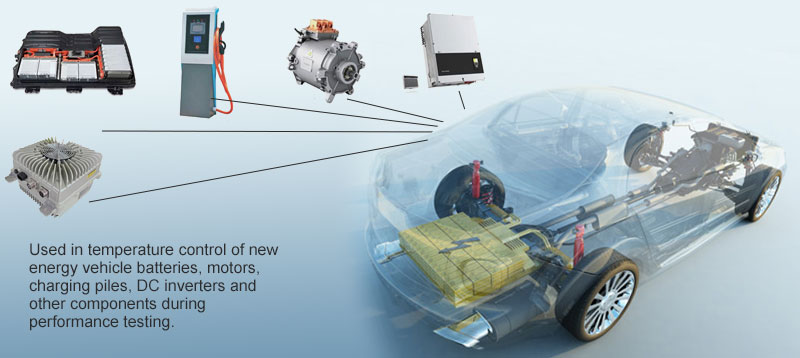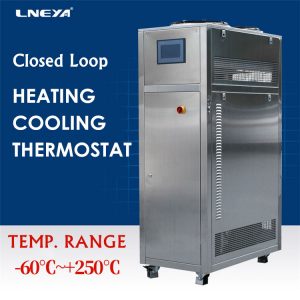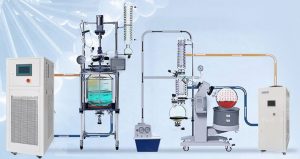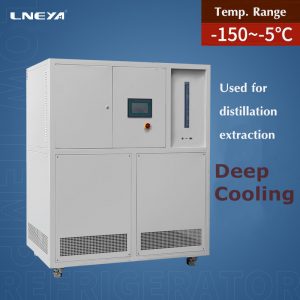The Effect of Battery Test Temperature Simulation System on Testing Electric/Hybrid Vehicle Cooling
In the electric vehicle industry, batteries are an important part of automobiles, and their performance directly affects the performance of hybrid/electric vehicles. For this reason, relevant manufacturers in the market have launched a battery cooling system test temperature simulation system to efficiently perform battery module charge and discharge tests.
Due to the limited space of the vehicle, the accumulation of heat generated during the operation of the battery will cause uneven temperature everywhere and affect the consistency of the battery cells. Thereby reducing the battery charge and discharge cycle efficiency, affecting the power and energy of the battery, in severe cases, it will also lead to thermal runaway, affecting system safety and reliability. In order to make the battery pack play better performance and life, the battery needs to be thermally managed to control the temperature of the battery pack within a reasonable range.
The battery thermal management system is one of the key technologies to deal with the battery’s thermal related problems and ensure the performance, safety and life of the power battery. The main functions of the thermal management system include: effective heat dissipation when the battery temperature is high to prevent thermal runaway accidents; preheating when the battery temperature is low, raising the battery temperature, ensuring charging and discharging performance and safety at low temperatures; Reduce the temperature difference within the battery pack, suppress the formation of local hot spots, prevent the battery from decaying too fast at high temperature locations, and reduce the overall life of the battery pack.
The temperature environment in the battery pack (PACK) has a great influence on the reliability, life and performance of the battery cell. Therefore, it is particularly important to maintain the temperature within the PACK within a certain temperature range. Air cooling is a kind of heat dissipation method that uses low temperature air as a medium and uses heat convection to reduce the temperature of the battery. It is divided into natural cooling and forced cooling (using a fan, etc.). Liquid cooling technology uses liquid convection heat exchange to remove the heat generated by the battery and reduce the battery temperature. The liquid medium has a high heat transfer coefficient, a large heat capacity, and a fast cooling rate. It has a significant effect on reducing higher temperatures and improving the consistency of the temperature field of the battery pack. At the same time, the volume of the thermal management system is relatively small. Direct cooling (refrigerant direct cooling) uses the principle of refrigerant (R134a, etc.) to evaporate latent heat, establish an air-conditioning system in the vehicle or battery system, install the evaporator of the air-conditioning system in the battery system, and the refrigerant evaporates in the evaporator And quickly and efficiently remove the heat from the battery system to complete the cooling of the battery system.
The heat-related problems of the battery are the key factors that determine its performance, safety, life and cost. The test cooling cycle system is an essential test equipment for new energy vehicles, battery modules, and battery PACK liquid cooling tests. Testing of motor and its controller. LNEYA battery cooling system test temperature simulation system effectively promotes the development of power battery performance, safety and life.
Recommandations connexes
-
The solution to the fully enclosed heating and cooling thermostat lack of refrigerant alarm
1285What should I do if the fully enclosed heating and cooling thermostat alarms for lack of refrigerant? I believe that many customers will encounter this problem when they use it. In fact, this is relatively simple. As long as we know the principle ...
Voir les détails -
Pourquoi y a-t-il un phénomène de gel dans le circulateur du refroidisseur à basse température ?
1113De nombreux circulateurs de refroidissement à basse température givrent lorsqu'ils sont utilisés, mais il n'y a pas de phénomène de givrage dans les circulateurs de refroidissement à basse température. Qu'est-ce qui se passe ? Est-ce lié à la réfrigération ? Tout d'abord, pourquoi les circulateurs...
Voir les détails -
Cooling method for laboratory evaporative instruments in operation
944Choosing the right cooling method for an evaporation experiment can have an unimaginable impact on overall system performance, economy, and efficiency. It is necessary to purchase cooling water circulation machine as supporting equipment. When pu...
Voir les détails -
Precautions for operation of ethylene glycol utra-low temperature chiller at minus 30 degrees
1063The minus 30 degree ethylene glycol utra-low temperature chiller is a device that is used more in the pharmaceutical and chemical industry. When using it, you need to pay attention to its operating specifications to operate it. If used improperly,...
Voir les détails
 LNEYA Industrial Chillers Fabricant Fournisseur
LNEYA Industrial Chillers Fabricant Fournisseur













